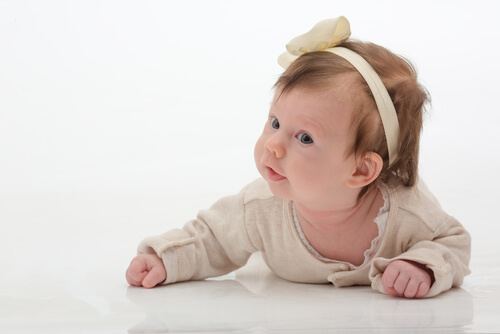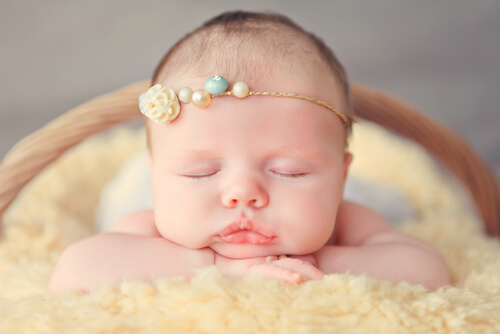Be Careful Using Headbands and Ribbons with Your Babies

The use of headbands and ribbons can be dangerous. You’ve probably heard that these accessories are capable of causing discomfort for your little girl.
So, whether it’s in fashion or not, or whether you are just trying to make your daughter even more beautiful; before adorning them with these accessories you should be aware of the possible harm that they can cause.
How to know if headbands and ribbons are harming my child?
In order to find out whether the headbands or colored ribbons that you put on your child’s head are harming them somehow, you just have to observe their behavior.
If when you place it on, they cry, get stubborn or try to take it off, then we will know that they are at least feeling uncomfortable. Childhood should be a pleasant period in all of its magnitude without any discomforts.
Another way to find out if these accessories are causing some kind of harm to your girl, is by observing them when it comes time to sleep. If they don’t sleep well, or find it difficult to fall asleep after having those accessories on for a long period of time, this can indicate that it is having harmful effects.

Lastly it is also important to know that the bones of a baby’s skull need to be free from pressure.
Their skulls are composed of seven bones, among which are structures. These are soft joints covered by membranes that allow for the growth of the skull as the brain also increases in size.
Alternatives to headbands and ribbons
In addition to headbands and ribbons, there are other common accessories that mothers choose as accessories. For example, bows, little flowers, butterflies and other accessories that are held by stickers or brooches. These accessories are not as confining as bands and ribbons.
However, these accessories can also be dangerous, although they do not cause compression of the child’s skull.
Babies that have developed psychomotor skills can remove these tiny ornaments and try to swallow them when no one is watching.
Therefore, before replacing headbands for these types of accessories keep in mind what we have just told you.
“A mother is more effective than ever when she trusts her own criteria”—Donald Winnicott
So, should I never put accessories on my daughter’s head?

This decision is completely your own as with everything that has to do with your baby. However, if at some moment you decide to have your child wear head accessories, we recommend the following tips:
- Choose headbands that are soft with a minimum amount of elastic. It is better to have one that constantly falls off rather than one that stays put due to contraction caused by the headband’s elastic.
- Use other types of small accessories (pinches, bows, butterflies…) This should be done when your daughter still hasn’t developed fine psychomotor skills to take them off. However, whenever you use these small accessories, it is important to keep an eye on them.
- Use these type of accessories on your daughter’s head at certain times only. For example, when you take her out of the house. Avoid using them all the time. They are not essential.
- Be prudent and cautious. Assess the pros and cons of these accessories and understand that the decision to use them or not is your responsibility as a mother and primary caregiver. Some specialists advise the use of these accessories only after the age of 6 months. Before making a decision you can also ask your paediatrician for their specialized advice.
“Why do we smile when we see a baby? Maybe it’s because we see someone who still does not have all those defensive barriers, when they smile at us, their smiles are totally authentic and without any sort of deception. The baby’s soul that we still have inside of us smiles back with melancholic gratitude.” – Jack Canfield.
The use of headbands and ribbons can be dangerous. You’ve probably heard that these accessories are capable of causing discomfort for your little girl.
So, whether it’s in fashion or not, or whether you are just trying to make your daughter even more beautiful; before adorning them with these accessories you should be aware of the possible harm that they can cause.
How to know if headbands and ribbons are harming my child?
In order to find out whether the headbands or colored ribbons that you put on your child’s head are harming them somehow, you just have to observe their behavior.
If when you place it on, they cry, get stubborn or try to take it off, then we will know that they are at least feeling uncomfortable. Childhood should be a pleasant period in all of its magnitude without any discomforts.
Another way to find out if these accessories are causing some kind of harm to your girl, is by observing them when it comes time to sleep. If they don’t sleep well, or find it difficult to fall asleep after having those accessories on for a long period of time, this can indicate that it is having harmful effects.

Lastly it is also important to know that the bones of a baby’s skull need to be free from pressure.
Their skulls are composed of seven bones, among which are structures. These are soft joints covered by membranes that allow for the growth of the skull as the brain also increases in size.
Alternatives to headbands and ribbons
In addition to headbands and ribbons, there are other common accessories that mothers choose as accessories. For example, bows, little flowers, butterflies and other accessories that are held by stickers or brooches. These accessories are not as confining as bands and ribbons.
However, these accessories can also be dangerous, although they do not cause compression of the child’s skull.
Babies that have developed psychomotor skills can remove these tiny ornaments and try to swallow them when no one is watching.
Therefore, before replacing headbands for these types of accessories keep in mind what we have just told you.
“A mother is more effective than ever when she trusts her own criteria”—Donald Winnicott
So, should I never put accessories on my daughter’s head?

This decision is completely your own as with everything that has to do with your baby. However, if at some moment you decide to have your child wear head accessories, we recommend the following tips:
- Choose headbands that are soft with a minimum amount of elastic. It is better to have one that constantly falls off rather than one that stays put due to contraction caused by the headband’s elastic.
- Use other types of small accessories (pinches, bows, butterflies…) This should be done when your daughter still hasn’t developed fine psychomotor skills to take them off. However, whenever you use these small accessories, it is important to keep an eye on them.
- Use these type of accessories on your daughter’s head at certain times only. For example, when you take her out of the house. Avoid using them all the time. They are not essential.
- Be prudent and cautious. Assess the pros and cons of these accessories and understand that the decision to use them or not is your responsibility as a mother and primary caregiver. Some specialists advise the use of these accessories only after the age of 6 months. Before making a decision you can also ask your paediatrician for their specialized advice.
“Why do we smile when we see a baby? Maybe it’s because we see someone who still does not have all those defensive barriers, when they smile at us, their smiles are totally authentic and without any sort of deception. The baby’s soul that we still have inside of us smiles back with melancholic gratitude.” – Jack Canfield.
This text is provided for informational purposes only and does not replace consultation with a professional. If in doubt, consult your specialist.








